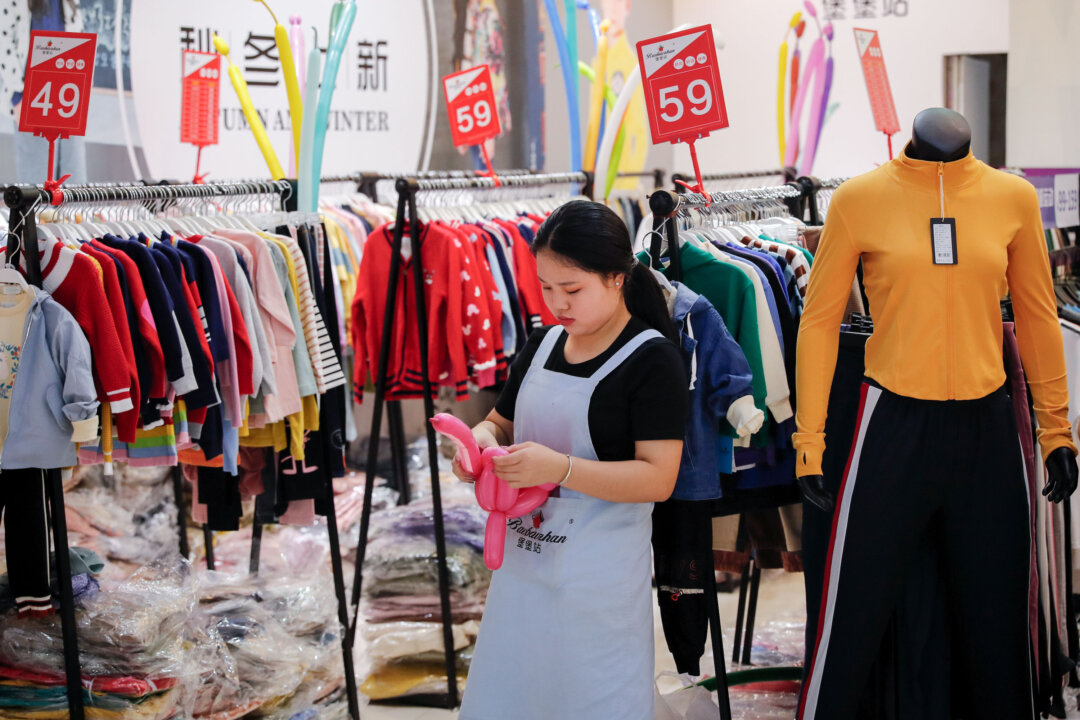The country’s dependence on investment and exports is threatening its economy at home and affecting prices worldwide.
News Analysis
China is a nation of thrifty savers rather than prosperous consumers. The Chinese people have yet to spend freely and enjoy the fruits of their hard work in line with their peers in other emerging market economies.
Low consumer spending has left China dependent on repeated fiscal and monetary stimulus policies that create asset bubbles and on exports that pit the country against its major trading partners.
It has been almost five decades since a dose of capitalism injected into a Soviet-style central planning system put China on the path to becoming the world’s second-largest economy. Per-capita gross domestic product (GDP) jumped from about $200 at the end of the Maoist era to about $13,000 in 2024.
Despite a growing per capita GDP, China has yet to become a consumer society, as did occur with the world’s largest economy—the United States—and other emerging market economies.
In 2023, China’s consumer spending accounted for 39.2 percent of GDP, up slightly from 35.6 percent a decade ago. Meanwhile, consumer spending is 67.8 percent of GDP in the United States, 63 percent of GDP in Brazil, 60.4 percent of GDP in India, and 52.7 percent of GDP in the European Union.
Low consumer spending has left the Chinese economy relying on other sources of growth. One of these is private investment spending on building homes, apartment complexes, and commercial centers. Another is government spending on infrastructure, including highways, railways, ports, and airports.
While some of these types of spending are necessary for an emerging economy trying to transition to a developed economy, they need to be better balanced, as evidenced by the scores of ghost buildings, ghost airports, and ghost highways in China. These were built by state-owned construction companies and financed by state-owned banks to keep the economy growing rather than to serve the genuine needs of the Chinese people.
A third source of growth for the Chinese economy is international trade—exports of goods and services to the country’s two largest markets, the United States and the European Union. In 2022, China’s trade as a percentage of GDP was 38.35 percent, up from 35.89 percent in 2019, compared with 27.04 percent for the U.S., 46.84 percent for Japan, and 49.97 percent for India.
China’s dependence on international trade for its growth was acceptable in the first decade following the country’s 1978 opening to world markets. Back then, China was a minor player in global trade, and the country’s exporters were “price-takers.” They could export as much as they would like without influencing world prices, thereby avoiding friction with their trade partners.
Today, however, China is a major player, making its exporters “price-makers.” They can influence world prices, pitting themselves against their trade partners, who find it hard to match prices.
That’s how China’s low consumer spending has turned from a domestic problem into an international issue.
Georgios Koimisis, associate professor of economics and finance at Manhattan University, said he sees China’s reliance on investment spending and exports as the cause rather than the result of the country’s low consumer spending.
“China’s low consumption-to-GDP ratio can be mainly attributed to its prolonged dependence on an investment and export-driven growth model, which has suppressed household incomes relative to GDP,” Koimisis told The Epoch Times.
“This model emphasizes capital accumulation and manufacturing competitiveness, often at the expense of salaries and social transfers. The result is a structural imbalance in households with limited disposable income, exacerbated by weak social safety nets that necessitate high precautionary savings.
“In addition, significant income inequality worsens these dynamics, with wealth concentrated among high earners who save more and spend less, leaving lower-income households with insufficient resources to drive consumption growth.”
China’s consumer spending problem and its repercussions for the broader economy are similar to what Japan faced in the 1980s.
Japan experienced rapid growth during this period. However, it failed to transition from an export-driven to a consumer-driven economy and relied on exports, private investment, and fiscal and monetary stimulus for growth.
These policies fueled friction with its trade partners and contributed to an unprecedented property bubble.
Then, the property bubble burst, and the country slid into a prolonged stagnation, causing it to fall from second to fourth place among the world’s top economies.
One reason that Japan failed to transition from an export-driven economy to a consumer-driven one is that the Japanese people worked long hours and saved a great deal. In the mid-1980s to early 1990s, the gross savings rate in Japan hovered at about 33 percent.
In recent years, Japan has made some progress in shifting toward a consumer-driven economy. By 2022, consumer spending accounted for roughly 54 percent of GDP, while the gross savings rate stood at 28.8 percent.
China has yet to make significant progress in becoming a consumer economy. The Chinese people work long hours and save a considerable amount of their income. As of September, the average work week in China was 48.6 hours, compared with 41.7 hours in India, 34.3 hours in the United States, and 31.2 hours in France. Additionally, China’s gross savings rate stood at 44.3 percent.
China’s inadequate pension system also depresses consumer spending for the older generations.
A recent report by the Rhodium Group confirms multiple factors that make Chinese people big savers rather than big spenders, such as low household income levels and a highly unequal income distribution.
The Rhodium Group sees no quick policy solutions for China’s slow pace of household consumption growth, but it calls for fiscal transfers to lower-income households and restructuring of the economy to ease the problem.
“Reducing savings rates alone is unlikely to boost overall spending significantly, given the low levels of savings among lower-income households,” the report states.

